We bought a Pitcher Plant at one of the local tropical plant sales and it has been hanging under one of our ligustrum trees for well over a year. I won’t speak for other’s plants, but our one and only insect eating plant is not very needy. When dry, it gets misted from our overhead drip misting system that we have winding thru the trees. And other than the misting, we just let this Nepenthes hang and watch it grow. We moved it to warmer shelter during the winter, but the leaves still took quite a beating, a few turning yellow and showing signs of cold damage.
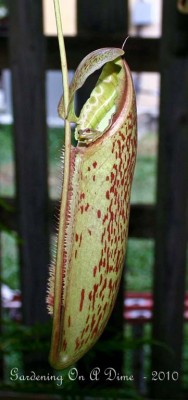
It really doesn’t look like much until the “traps” emerge from the tips of the leaves. The first time this happened, we realized why folks enjoy collecting these unique plants.
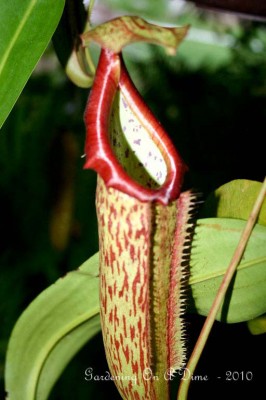
I went to find more information about this hanging plant . On the web, there were dozens of collectors sites with more information than I could digest. (no pun intended) So, I sorted out enough information to give me a better appreciation for these insect eating plants.
Nepenthes are carnivorous plants, native to Southeast Asia and Australia. They form pitchers that hang from tendrils which emerge from the tips of the leaves. We have pitcher plants in North America that use the same type of trap. They both develop a pool of water at the bottom of the pitcher to trap insects.
Our particular plant supports the pitchers by twining the tendril around our other plants that are hanging next to it.
The trap attracts insects using a combination of decaying odors and red coloring. The bigger it gets, the more it swells and the lower it hangs.

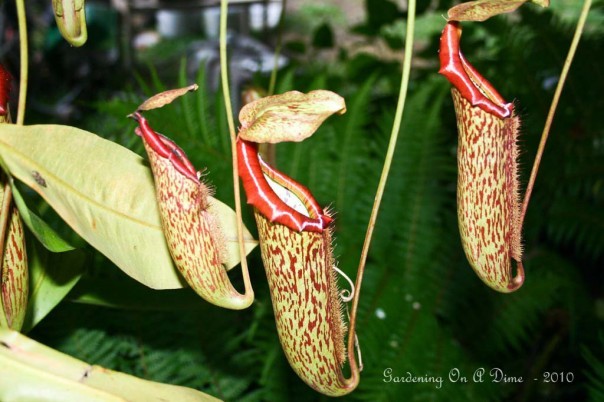
As it swells up, it fills with liquid and opens up, ready for dinner. I thought the lid closed, but actually it remains closed only during the development stage. At maturity, the lid stays open. The odor attracts the insects. Once the bugs get inside, they find that they cannot keep a grip on the walls of the trap. Sooner or later, they fall into the water. The movement from their struggle causes the plant to release digestive acids. That said, dinner has now been served and the process will be complete within a few hours.
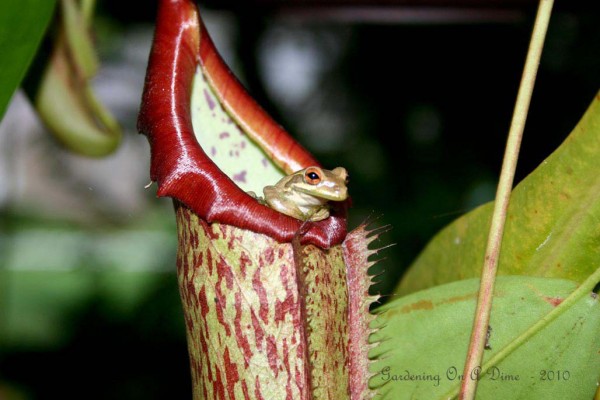
As for our frog friend, he seems to have a good grip on the situation.
Happy Gardening,
Dave and Trish
P.S. A tip I’ve heard is to hang one of these in your kitchen to trap pesky fruit flies that sometimes wander in with the produce.
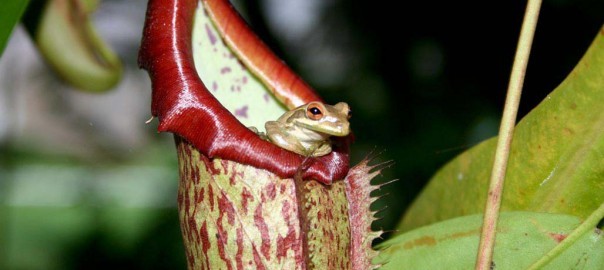
I had a pitcher plant. 2 winters ago I lost it : ( Forgot to bring it in one night when the temp hit freezing. I miss it. Wish I could find another one for a good price.
I know the feeling. We lost one to the cold too. They are not the type of plant that you find at Wally-World or the big box home improvement stores. And, you are correct, they can be pricey. Time to find a good tropical plant sale.
How long before the plant starts to grow pitchers? It grows alot of leaves, but no pitchers yet.
Blake,
Not knowing your area or conditions, I can only tell you our experiences.
These plants like bright light and thrive on high humidity. Leaf growth throughout spring and summer. As the summer rains, high heat and humidity increase, the pitchers develop from the tips of the leaves. In our area, that’s late July, August and early September. As soon as the humidity starts dropping at summer’s end, the pitchers shrivel. Grown indoors, they like bright bathrooms and kitchens (again, lots of humidity).